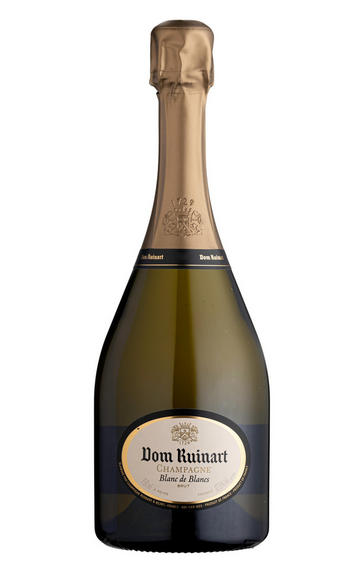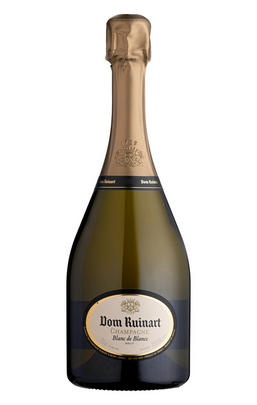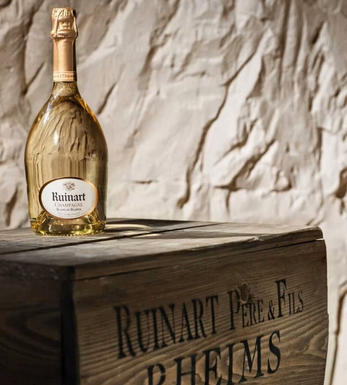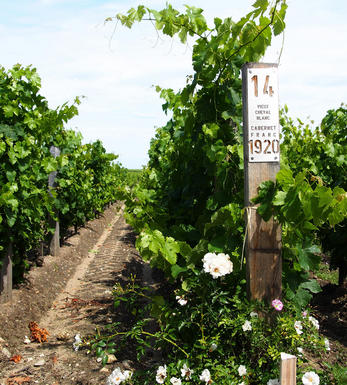
1996 Champagne Dom Ruinart, Blanc de Blancs, Brut

Critics reviews
The 1996 Dom Ruinart is beginning to enter the second stage of its life post-release, where the aromas and flavours are starting to show hints of development. Orange peel, apricot jam, spices and mint are vivid and beautifully delineated in the glass. The 1996 remains fresh and vibrant on the palate, with remarkable depth and more than enough pure intensity to drink well for another 15-20 years. Readers looking for a 1996 Champagne to drink now will find considerable pleasure in the 1996.
Drink 2014 - 2031
Antonio Galloni, Vinous.com (March 2014)
Pale gold with an energetic mousse. The highly aromatic nose offers a sexy, smoky perfume of pear, white peach, candied lemon, buttery brioche and honeysuckle. Youthfully firm, palate-staining green apple and citrus flavours are complicated by gently toasty lees; chewy in texture, with an expansive but vibrant back end. Serious, penetrating and deep wine, with outstanding clarity and lingering finishing flavours of tangerine, lemon pith and spiced pear. Very impressive but awfully young, with the concentration and balance to repay ten or more years of cellaring.
Josh Raynolds, Vinous.com (November 2007)
100% Chardonnay
Pale yellow colour. Rather light nose. No excess of fruit on the palate! Bone dry but a nice texture. Rather muted and well mannered. Very polite. No sweetness. But well balanced. I should imagine in bottle sizes this wine is at its apogee (but the drink dates refer to this magnum size). Very fresh and clean and brisk with a certain nuttiness.
Drink 2015 - 2030
Jancis Robinson MW, JancisRobinson.com (July 2016)
Classic aged Dom Ruinart nose – toasty, not yeasty, in the house’s reductive style. Brilliant, bright acidity, the servant rather than the master of the wine. Mineral-wrapped green fruits are precise and linear, finishing with endless complexities. Grand vin!
Drink 2017 - 2025
Michael Edwards, Decanter.com
About this WINE

Champagne Ruinart
Ruinart is a low profile, yet select, Champagne house which is steeped in history. It dates back to the 17th century, the time of the famous Dom Pérignon. It was founded in 1729 by Nicolas Ruinart in the city of Reims, the year after a Royal Decree in 1728 whereby Louis XV gave his consent for sparkling wines to be shipped in baskets containing 50 to 100 bottles. This opened the gates of Europe to champagne and thus makes Ruinart the oldest Champagne House. Nicolas' uncle was Dom Thierry Ruinart, close friend to Dom Pérignon himself and an inspiration behind the creation of this house after the Dom’s death. Its Gallo-Roman chalk cellars are now a UNESCO-classified historical monument and every two years the finest sommeliers in Europe gather there to compete for the Trophée Ruinart.
Since the second world war the house has become synonymous with class and its production of only 1.7 million bottles per annum is small compared to other grande marques. It is now part of the LVMH group that also owns Moët & Chandon.
The house style emphasises the pre-eminence of Chardonnay over Pinot Noir and Pinot Meunier.
The 'R' de Ruinart NV contains 40% Chardonnay minimum, with 25% reserve wines. Ruinart Blanc de Blancs is 100% Chardonnay, sourced predominantly from Premier Cru vineyards, while Ruinart Brut Rosé is typically 45% Chardonnay and 55% Pinot, of which 18% is red wine, so following the assemblage, rather than the saignée method of rosé production.
The Dom Ruinart range, named for the spiritual father of the House, represents the prestige cuvées of the house. Dom Ruinart Blanc de Blancs is a Grand Cru Chardonnay, predominantly from the Côte des Blancs (70%) and the remainder from the Montagne de Reims.
Dom Ruinart Rosé champagne has the same basis as the Blanc de Blancs (Chardonnay) to which 15%-20% red wine (Pinot Noir from Verzenay and Verzy) has been added. These are amazingly rich and pure in youth developing red Burgundian notes with long ageing such as in the 1988 or 1990 vintages.

Blanc de Blancs
In Champagne, the term Blanc de Blancs designates Champagnes made only from Chardonnay grapes. The vineyards located between Cramant and Mesnil-sur-Oger in Cote de Blancs yield the best examples of the style.
A classic Blanc de Blancs is restrained and elegant when young, yet with ageing it develops a mouth-coating brioche richness that overlays an intense expression of fruitiness. Blanc de Blancs are endowed with longer ageing potential than a typical Blanc de Noirs.
Recommended Producers: Salon, Billecart Salmon, Jacques Selosse, Dom Ruinart, Krug, Le Mesnil Grand Cru, Guy Larmandier

Chardonnay
Chardonnay is often seen as the king of white wine grapes and one of the most widely planted in the world It is suited to a wide variety of soils, though it excels in soils with a high limestone content as found in Champagne, Chablis, and the Côte D`Or.
Burgundy is Chardonnay's spiritual home and the best White Burgundies are dry, rich, honeyed wines with marvellous poise, elegance and balance. They are unquestionably the finest dry white wines in the world. Chardonnay plays a crucial role in the Champagne blend, providing structure and finesse, and is the sole grape in Blanc de Blancs.
It is quantitatively important in California and Australia, is widely planted in Chile and South Africa, and is the second most widely planted grape in New Zealand. In warm climates Chardonnay has a tendency to develop very high sugar levels during the final stages of ripening and this can occur at the expense of acidity. Late picking is a common problem and can result in blowsy and flabby wines that lack structure and definition.
Recently in the New World, we have seen a move towards more elegant, better- balanced and less oak-driven Chardonnays, and this is to be welcomed.


Buying options
Add to wishlist
Description
The 1996 Dom Ruinart is beginning to enter the second stage of its life post-release, where the aromas and flavours are starting to show hints of development. Orange peel, apricot jam, spices and mint are vivid and beautifully delineated in the glass. The 1996 remains fresh and vibrant on the palate, with remarkable depth and more than enough pure intensity to drink well for another 15-20 years. Readers looking for a 1996 Champagne to drink now will find considerable pleasure in the 1996.
Drink 2014 - 2031
Antonio Galloni, Vinous.com (March 2014)
wine at a glance
Delivery and quality guarantee